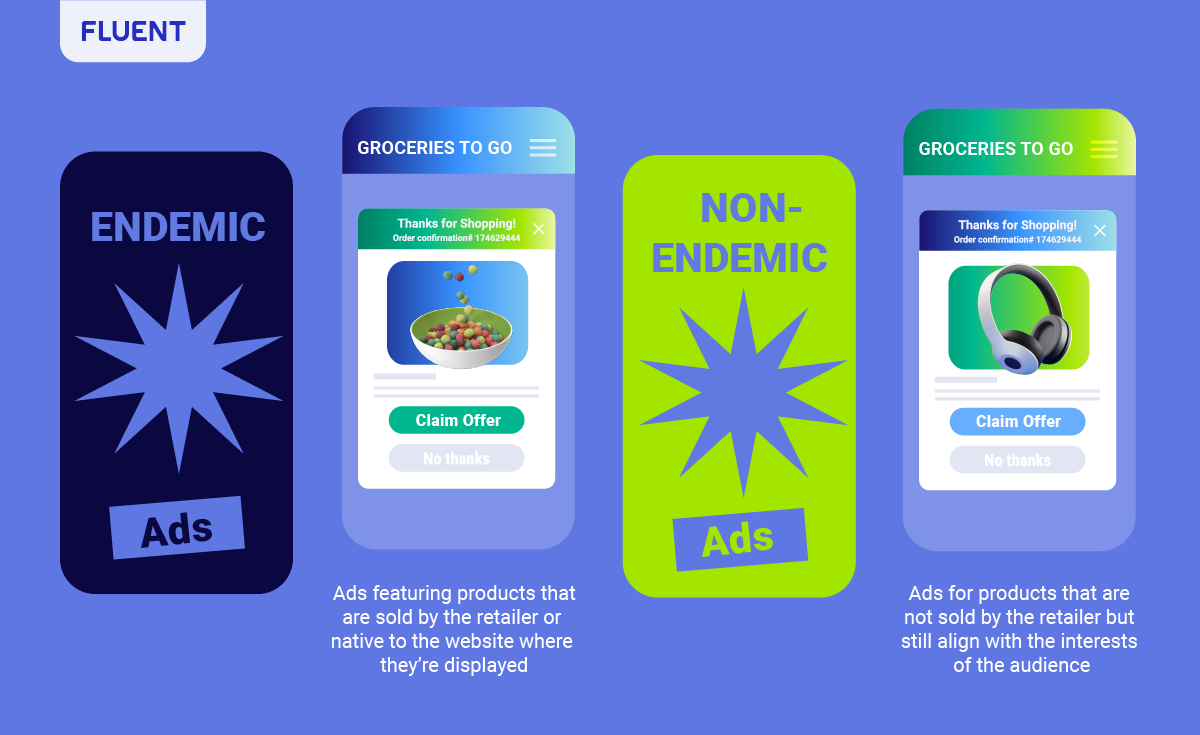
It’s time to view customers three-dimensionally; not as merely people who buy sunglasses, or groceries, or dog food, but people who like to travel with their dogs and take long hikes while exploring fun restaurants and buying new art pieces.
And. Not or.
This holistic approach unlocks new monetization opportunities for retailers by allowing them to welcome non-endemic advertising into the retail media space.
While non-endemic advertising is still gaining traction, it’s quickly becoming a must-have strategy for savvy retailers looking to diversify their revenue streams and deliver richer shopping experiences.
The Evolution of Retail Media Advertising: From Endemic to Everything
Endemic ads feature products that are sold by a retailer or native to the website where they’re displayed. Some examples include an ad for a lawn mower on a home improvement site or running shoes advertised on a sporting goods page.
For many years, this type of advertising dominated retail media. This made sense. These ads were a safe bet, and they worked.
However, thanks to advancements in ecommerce data, retailers can now confidently open their online “aisles” to non-endemic brands and attract a wider range of advertisers.

This doesn’t mean advertising becomes a chaotic mess. Just the opposite. Non-endemic ads must still be highly curated and relevant, but there’s room for creativity in a way that there isn’t with endemic advertising.
Let’s take a look at the data that makes this possible.
Leveraging Unique First-Party Data: Your Secret Sauce
First-party data is the hero leading the charge of non-endemic advertising. This is data that companies collect directly from their customers via the company’s own website, emails, apps, and social media.
It includes information such as how many times customers visit a website, what they purchase, what they look at, what emails they subscribe to and open, and how they interact with loyalty programs and apps. It also includes information from customer surveys and interactions on social media.
With more consumers choosing to opt out of third-party data collection, advertisers are becoming increasingly data-poor. In effect, they are operating blindly. Retailers with first-party data change all that.

This data, collected over time, allows retailers to create highly targeted audiences. Retailers can help advertisers reach consumers with more relevant ads because they understand shoppers’ preferences through the lens of their past actions. They can also better predict consumer behavior, ensuring shoppers only receive the offers they’re likely to convert on.
Leveraging this data provides a win-win opportunity for brands and retailers to generate new revenue streams and enhance the customer shopping experience. Think of first-party data as the silent matchmaker—it makes it possible for retailers to cheerfully introduce a shopper (through non-endemic ads) to the new item or service they didn’t know they needed but will be happy to have.
Why Non-Endemic Advertising Matters: More Aisles, More Smiles
Non-endemic advertising opportunities are growing in adoption, with more than half (53%) of brands in the US taking advantage of non-endemic data and media network offerings. Why? These brands recognize the value of tapping into retailer data to reach niche audiences with highly relevant content and offers.
Here’s a quick overview of other key benefits brands and advertisers can expect;
- Expanded Reach: Brands can target new audiences outside their typical industry or category.
- Contextual Relevance: Brands can engage consumers at moments that align with their needs or interests.
- Brand Safety: Ads on retailers’ owned platforms give advertisers confidence that the surrounding content is safe and contextually appropriate.

Putting Non-Endemic Advertising to Work
Non-endemic advertising partnerships also offer a compelling value proposition for retailers that find the right brands to complement their existing product assortment. This is especially true for retailers in categories like grocery who want to level up the customer experience while also scaling their retail media business beyond a finite pool of endemic brands.
With non-endemic ads, online shopping aisles are becoming more interesting. They show customers that retailers can be trusted to do more than sell their own products. They can also help shoppers discover items that complement and complete their other purchases. It doesn’t get better than that.
Just take it from Fanatics, a leading sportswear retailer focused on building non-endemic brand partnerships. Watch below to hear from Josh Winkler, SVP Global Partnerships Solutions at Fanatics, as he shares how retailers can position themselves as powerful allies to non-endemic brands.
Enhancing the Customer Experience: A Better Shopping Trip
Now that we’ve covered the benefits to advertisers and retailers, how exactly do non-endemic ads work? Here are a few examples of ways to enrich the customer experience:
- Customer 1 buys coffee and sees ads for home office organizers
- Customer 2 buys toys and sees ads for family vacation spots
- Customer 3 buys moving supplies and is delivered ads for home insurance
Each situation paints a picture of who this shopper is outside of one online purchase. And remember, thanks to unique first-party retailer data, these aren’t blind guesses. Rich insights allow brands and retailers to create on-point personalized offers and content.
Unlock Retail Media Potential with Non-Endemic Ads
Non-endemic advertising is reshaping the retail media landscape. To stay ahead, retailers need a strategic approach that sets them apart.
Fluent’s post-purchase monetization solution makes it easy to integrate non-endemic ads into the customer journey. Delivered during the online checkout experience, post-purchase ads open up a new revenue stream without alienating customers or cannibalizing sales for endemic brands.
Ready to expand the shopping experience beyond your core product offerings with post-purchase ads? Get in touch today to begin.
Check out more resources to get fluent in:
Commerce Media | Retail Media | Post-Transaction Advertising | First-Party Data